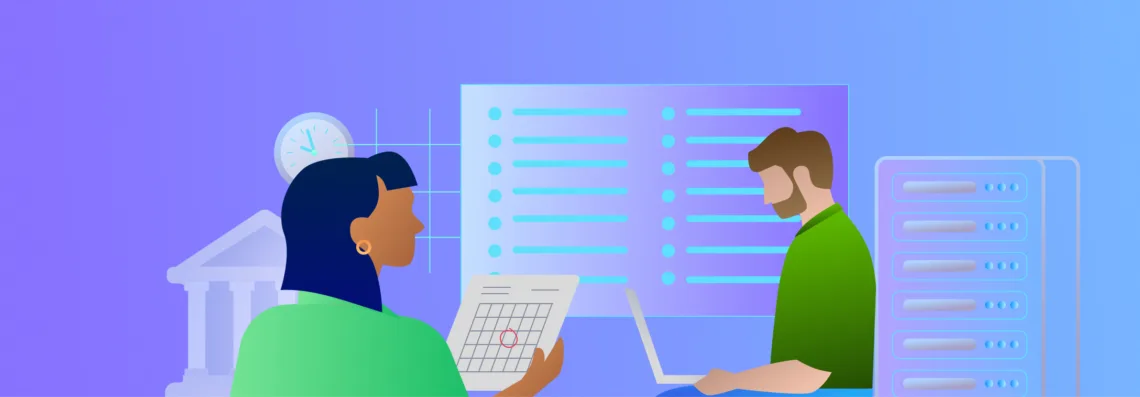Banks and credit unions are set to undergo significant transformation (if they haven’t already) in response to the Federal Reserve Bank’s forthcoming regulatory changeover to ISO 20022 messaging standards in the US, taking effect in spring 2025. This new standard marks a comprehensive shift in how financial institutions manage and process payments. Financial institutions should view the shift to ISO 20022 as a regulatory requirement and a strategic opportunity to modernize their payment systems and strengthen their competitive edge. This blog explores the key aspects of ISO 20022, its implications, and how banks and credit unions should take immediate action to prepare.
What is ISO 20022?
ISO 20022 is a global standard used worldwide to streamline financial communications. It makes transactions faster, more efficient, and more transparent by providing a consistent way to share information about payments, investments, and other financial activities. XML, a computer language, to structure data, ensuring that financial institutions (FIs) can exchange information smoothly. In simpler terms, think of ISO 20022 as a universal translator for the financial world, helping banks and other institutions communicate more effectively and process transactions with ease.
How ISO 20022 adoption gained momentum in the US
In March 2025, the Federal Reserve will require wire transfers to switch from the current Fedwire Application Interface Manual (FAIM) format to ISO 20022. This change aligns with the global momentum towards standardization and interoperability. FedNow, the Federal Reserve’s real-time payments service, will also adopt ISO 20022, ensuring consistency across payment systems.
Visa is an early adopter of ISO 20022, promoting its implementation to enhance global financial exchanges through its DPS Forward service, which supports the standard’s messaging format for efficient digital payment solutions. Mastercard has advocated for ISO 20022 as part of its payment system modernization efforts, highlighting the benefits of enabling interoperable connections between multiple payment systems globally.
Additionally, Nacha partnered with the Federal Reserve for a proof of concept that demonstrated the feasibility of supporting end-to-end ISO 20022 payment messaging within the ACH (Automated Clearing House) Network, though it highlighted the need for standardization to fully align with its requirements.
Why ISO 20022 matters to US financial institutions
The transition to ISO 20022 is a significant development for US FIs, offering numerous advantages that align with modern payment systems and regulatory requirements globally. The shift to this standard in the US will enhance the overall efficiency, transparency, and security of financial transactions, making it crucial for FIs to adopt and integrate it effectively.
Key benefits of ISO 20022:
Enhanced Data Quality: The rich data format allows for more detailed transaction information, improving the accuracy and reliability of financial data.
Operational Efficiency: Standardizing messaging formats reduces the complexity of payment processing, leading to streamlined operations and reduced processing times.
Regulatory Compliance: Compliance with ISO 20022 ensures that FIs meet global standards, reducing the risk of regulatory penalties and enhancing reputational integrity.
Improved Fraud Detection and Prevention: The enhanced data structure facilitates better monitoring and analysis of transactions, aiding in the early detection and prevention of fraudulent activities.
Seamless Cross-Border Transactions: ISO 20022 supports interoperability between different payment systems worldwide, enabling smoother and more efficient cross-border transactions.
Preparing for ISO 20022
ISO 20022 is right around the corner, set to take effect in spring 2025. However, if FIs take action now, it’s not too late to prepare for this monumental moment. Effective preparation involves several strategic steps institutions must undertake to avoid disruptions and remain competitive.
Key steps to prepare for ISO 20022:
Conduct a Gap Analysis: Assess current systems and processes to identify areas that need upgrading or modification to comply with ISO 20022.
Invest in Technology: Implement technology solutions that support ISO 20022 messaging standards, such as upgrading existing payment systems or adopting new platforms that facilitate ISO 20022 compliance.
Train Your Team: Through training programs and workshops, ensure that staff are well-versed in ISO 20022 standards and their implications.
Collaborate with Partners: Work closely with payment processors, vendors, and other stakeholders to ensure a smooth transition.
Test and Validate: Thoroughly test and validate systems to ensure they can effectively handle ISO 20022 messages.
Best practices for rapid ISO 20022 compliance with iPaaS and integrated payments management solutions
To achieve rapid compliance with ISO 20022, FIs should utilize an Integration Platform as a Service (iPaaS) that includes integrated payments management solutions. Incorporating straight-through processing – fully automated handling of wire payments from the Federal Reserve to the banking core (such as Fiserv, JHA, or FIS) – empowers institutions to scale transaction volumes without creating bottlenecks for their payment teams. This approach streamlines compliance and supports the scalability and efficiency necessary to handle increasing transaction demands.
How iPaaS expedites compliance with ISO 20022
An iPaaS with integrated payments management offers several critical features that facilitate swift ISO 20022 compliance:
Unified Integration Platform: A robust iPaaS enables seamless integration of various financial systems, ensuring compatibility with ISO 20022 standards. This unified approach simplifies the transition by consolidating all necessary components into a cohesive platform.
Scalability: Designed to scale with the institution’s needs, an effective iPaaS accommodates growing transaction volumes and evolving regulatory requirements. This scalability ensures that the platform remains efficient and capable as the institution expands.
Flexibility: The platform supports various financial applications and allows flexible integration and customization to meet specific business needs. This adaptability ensures that the iPaaS can handle diverse use cases and requirements.
A payments management platform should automate the compliance process
Incorporating a payments management solution within the iPaaS framework should streamline the compliance process and enhance payment operations:
Automated Compliance: A payments management solution automates the compliance process with ISO 20022 standards, reducing manual effort and minimizing errors. This automation ensures that institutions can meet regulatory requirements efficiently and consistently.
Real-Time Processing: The solution improves transaction accuracy and speed by processing payments in real time and leveraging the enhanced data capabilities of ISO 20022. Real-time processing is crucial for maintaining operational efficiency and meeting customer expectations.
Security and Transparency: Integrated security features and detailed transaction insights enhance the overall security and transparency of payment processes. This ensures that institutions can protect against fraud and provide clear visibility into financial transactions.
By adopting an iPaaS with integrated payments management, FIs can streamline their transition to ISO 20022, ensuring rapid compliance while enhancing operational efficiency. This approach meets regulatory standards and empowers institutions to innovate and adapt in a dynamic financial landscape.
Don’t wait: Modernize your wire transfer compliance today
The time to act is now!
FIs unprepared for ISO 20022 will need to take massive and immediate action, as the magnitude of this transition requires significant time and resources. Delaying action increases the risk of non-compliance, the potential for operational disruptions, and missed opportunities for efficiency gains.
ISO 20022 also represents a strategic opportunity for FIs to modernize their payment systems and enhance their competitive edge. By taking proactive steps and leveraging solutions like PortX’s Fintech Hub and Payment Manager, institutions can ensure a smooth transition and position themselves for success. The spring 2025 deadline is fast approaching – talk to our team today to learn how PortX can help automate your compliance with ISO 20022.






